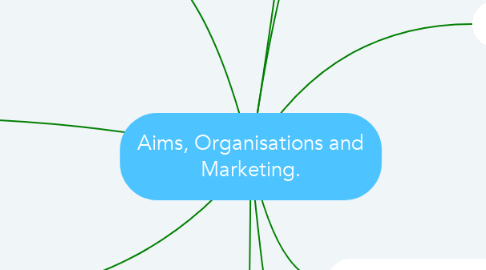Aims, Organisations and Marketing.
by Lucie Scott

1. Market Mapping
1.1. Market mapping helps businesses to identify gaps in the market.
1.2. A market segment is a group of customers with similar needs.
1.3. A market mapping diagram can be used to compare products in a market.
2. Added Value
2.1. Added value is the increased worth that a business creates for their product.
2.2. A USP is a unique selling point
2.3. A brand is a named product that customers see as being different from other products.
3. Franchising
3.1. A franchise is the right given by one business to other businesses to sell goods using its name.
3.2. A franchisor is the business that gives the right to sell its product.
3.3. A franchisee is the business that agrees to sell a branded product under license by a franchisor.
4. Thinking Creatively
4.1. Deliberate creativity is the intentional creation of ideas.
4.2. Blue skies thinking is coming up with as many ideas as possible to solve a problem.
4.3. Lateral thinking involves thinking differently to find new ideas.
4.4. De bono's six thinking hats: white hat- facts red hat- emotions black hat- difficulties yellow hat- positives green hat- creativity blue hat- thinking
5. Invention and Innovation
5.1. A patent is the right of ownership of an invention when it is registered with the government.
5.2. Copyright is legal ownership of material which prevents these from being copied.
5.3. A trademark is the logo, symbol or sign that can't be copied by others.
6. Businesses
6.1. A business is an organisation that produces goods and services.
6.2. A supplier is a business that sells it's products to another business.
6.3. Production is the use of raw materials to make products.
6.4. A customer is someone who buys the product or service.
6.5. A consumer is someone who uses the product.
6.6. A market is where buyers and sellers meet to trade goods.
7. Understanding Customer Needs
7.1. Primary research is collecting data that doesn't already exists.
7.2. Secondary research is collecting data that already exists.
7.3. Qualitative data is information about opinions and judgements.
7.4. Quantitative data is information that can be expressed as numbers.
8. Enterprise
8.1. An entrepreneur is a person who owns and runs a business and takes risks.
8.2. Enterprise is the willingness of an individual to take risks.
8.3. Enterprises are another word for a business.
9. Enterprise Skills and Qualities
9.1. Enterprise Skills- Planning, Drive, Thinking ahead, Determination, Seeing opportunities.
9.2. The Marketing Mix- Product, Price, Promotion, Place.
9.3. Entrepreneur Qualities- Planning, Initiative, Taking risks, Determination, Making decisions, Persuasion, Leadership and Luck


